Are you looking for a homeopathic cure for acne? This article discusses the homeopathy treatment of acne along with the best homeopathic medicine for acne treatment.
What is ACNE?
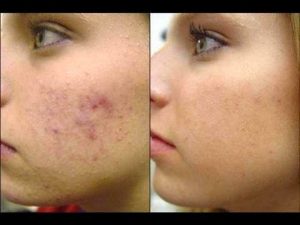 Acne is a general term for pimples and deeper pustules that are clogged pores. If severe enough acne can leave permanent scars.
Acne is a general term for pimples and deeper pustules that are clogged pores. If severe enough acne can leave permanent scars.
It is an inflammatory skin disorder of the skin’s sebaceous glands and hair follicles that affects about 80% of people between the ages of 12 and 24. During puberty high levels of hormones are produced in both girls and boys. This leads to the production of large quantities of sebum.
Sebum is an irritant that can clog the pores and form a pimple which may become infected and form a pustule. Hormones don’t go away after adolescence. Many women still get premenstrual acne from of the release of progesterone after ovulation.
Acne is a disease that affects the skin’s oil glands. The small holes in your skin (pores) connect to the oil glands under the skin. These glands make an oily substance called sebum. The pores connect to the glands by a canal called a follicle.
Inside the follicles, oil carries dead skin cells to the surface of the skin. A thin hair also grows through the follicle and out to the skin. When the follicle of a skin gland clogs up, a pimple grows. Most pimples are found on the face, neck, back, chest, and shoulders. Pimples are not a serious health threat but it can cause scars.
Although bacteria play an important role in the development of acne or pimples, it is not caused by bacterial infection. They are caused by excessive secretion of oily substance called sebum by the sebaceous glands.
The lesions of acne are usually situated on the cheeks, chin, nose and temporal region, shoulder, back and front part of the chest may involve in severe cases. Occasionally one can see the lesions on the buttocks also. The types of lesions vary from patient to patient but majority of the patients have multiple types of lesions.
Homeopathic Medicines for ACNE
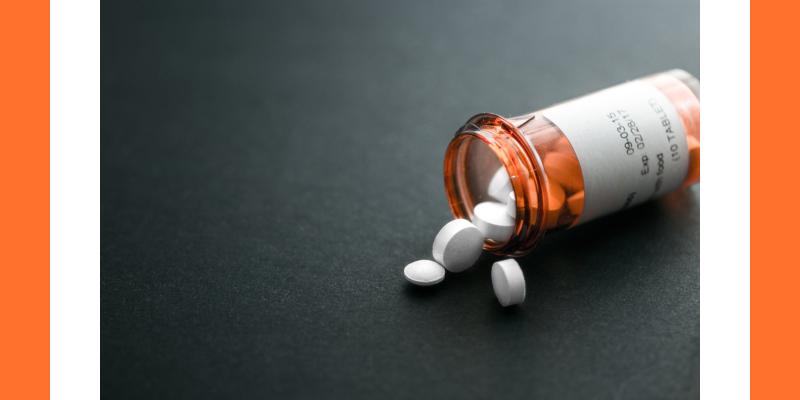
Homeopathy is one of the most popular holistic systems of medicine. The selection of homeopathic medicine for acne is based upon the theory of individualization and symptoms similarity by using holistic approach.
This is the only way through which a state of complete health can be regained by removing all the sign and symptoms from which the patient is suffering.
The aim of homeopathy is not only to treat acne but to address its underlying cause and individual susceptibility.
As far as therapeutic medication is concerned, several homeopathy remedies are available for acne treatment are there, which can be selected on the basis of cause, sensations and modalities of the complaints.
For individualized remedy selection and treatment, the patient should consult a qualified homeopathic doctor in person. Following remedies are commonly helpful in the treatment of acne:
Antimonium crud – acne on the face and shoulders with dry skin in fatty persons. Small red pimples on face, acne in drunkards with gastric derangement, thirst and white-coated tongue. Face with sad expression. Fat, fretful, cross and peevish; cries if looked at, touched or washed.
Ecstatic, dreamy, sentimental. Obese patient who eat uncontrollably. Patient has aversion to bathing. Patient usually talks in rhymes
Arsenic album – an excellent homeopathy remedy for acne on the nose. Acne has itching, burning, swellings; oedema. Papular eruptions dry, rough, scaly; worse cold and scratching.
Burning is very marked in all kind of skin eruptions. Burning in eruption is ameliorated by applying warm water is a strong characteristic of the remedy. Patient is often very anxious and restless about her disease.
Asterias rub – face Pimples on side of nose chin and mouth. Disposition to pimples at adolescence. Pimples on the face at the age of puberty. Constipation. Ineffectual desire. Stool like olives. Diarrhoea, watery brown, gushing out in jet.
Belladonna – acne red in color, burning and painful. Acne rosacea. Alternate redness and paleness of the 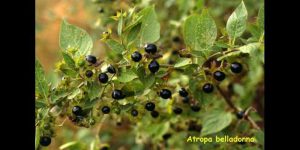 skin. Skin dry, hot and swollen. pustules on face. Face is red, bluish-red, hot, swollen, and shining.
skin. Skin dry, hot and swollen. pustules on face. Face is red, bluish-red, hot, swollen, and shining.
Patient is restless and talks fast. Acuteness of all senses. It has a marked action on the vascular system, skin and glands. Belladonna always is associated with hot, red skin, flushed face, glaring eyes.
Heat, redness, throbbing and burning in acne is a particular symptom. Belladonna is never indicated without redness, heat and hypersensitivity to touch.
Berberis aquifolium – acne, pimples and blotches on the face. Pimply, dry, rough, scaly. Eruption on scalp extending to face and neck. A homeopathic remedy for the skin which stimulates all glands and improves nutrition and Clears the complexion.
Borax – remarkable homeopathic medicine for acne on the nose and the lips. Acne from use of cosmetics. face pale, earthy, with suffering expression. Swollen, with pimples on nose and lips. Unhealthy skin; slight injuries suppurate.
Extreme anxiety, especially from motions which have a downward direction, rocking, being carried downstairs, laid down. Anxious expression of face during the downward motions, starts and throws up hands on laying patient down, as if afraid of falling.
Bovista – Homeopathic medicine for acne used when acne develops from the use of cosmetics; especially during summer. Pale swelling of cheeks. Skin itching, especially when getting warm, not better by scratching. Skin eruption due to artificial jewelry.
Any kind of skin complaint after over use or misuse of cosmetics. Sadness, with restlessness. Easily offended: takes everything in bad part.
Calcarea carb – Impaired nutrition is the keynote of its action. Specially acts on the glands, skin, and bones. Skin unhealthy; readily ulcerating; flaccid. Small wounds do not heal readily.
Craving for eggs, lime, earth etc. Thirst; longing for cold drinks. Calcarea patient is often fat, fair, flabby and perspiring. Sweat is cold and sour. Patient is often chilly with cold hands and feet.
Patient is mild and shy in temperament but can be obstinate with loved ones. Timid and fearful. Constipation since childhood.
Calcarea Phos – One of the most important tissue remedies, and while it has many symptoms in common with Calcarea carb, there are some differences and characteristic features of its own.
It is especially indicated in tardy dentition and troubles incident to that period, bone disease non-union of fractured bones, and the anemia after acute diseases and chronic wasting diseases.
Acne of anemic girls at puberty, associated with menstrual troubles. Acne in anemic girls at puberty, with vertex headache and flatulent dyspepsia, relieved by eating. Skin is dark – brown, yellowish. Red, with prickling like nettles after a bath.
Calcarea sulph – acne and pustules on the face and around ears with the discharge of yellow secretion. Suppurative processes come within the range of this remedy, after pus has found a vent.
Mucous discharges are yellow, thick and lumpy. Cuts, wounds, bruises, etc, unhealthy, discharging pus; they do not heal readily. Yellow, purulent crusts or discharge.
Purulent exudations in or upon the skin. Skin affections with yellowish scabs. Many little matterless pimples under the hair, bleeding when scratched.
Dulcamara – Hot days and cold nights towards the close of summer are especially favorable to the action of Dulcamara, and is one of the remedies that correspond in their symptoms to the conditions found as effects of damp weather, colds after exposure to wet.
Humid eruption on cheeks and face generally. acne on face around menstrual period, in humid weather. Skin itching always worse in cold, wet weather. Vesicular eruptions. Sensitive bleeding ulcers. Little boils. Red spots, urticaria, brought on by exposure. Humid eruptions on face, genitals, hands, etc. Thick, brown-yellow crusts, bleeding when scratched.
Eugenia – Eugenia produces a state of intoxication like alcohol. Everything appears beautiful and larger; excitement soon changing to depression.
Acne, simple and indurated. The pimples are painful for some distance around. Acne rosacea. Nausea, better smoking. Comedones. simple and indurated acne, painful, black heads, red pimples on the sides of nose, mouth, and chin.
Graphites – Like all the carbons, this remedy is an anti-psoric of great power, but especially active in patients who are rather stout, of fair complexion, with tendency to skin affections and constipation, fat, chilly, and costive, with delayed menstrual history, take cold easily.
Itching pimples. Moist eczema around mouth and chin. Erysipelas, burning and stinging. Pimples and acne. Eruptions, oozing out a sticky exudation.
Rawness in bends of limbs, groins, neck, behind ears. Unhealthy skin; every little injury suppurates. Ulcers discharging a glutinous fluid, thin and sticky.
Hepar sulph – Papules prone to suppurate and extend. Pimples in youth. Suppurate with prickly pain. Easily bleed. Unhealthy skin; every little injury suppurates. Cannot bear to be uncovered; wants to be wrapped up warmly.
Sticking or pricking in affected parts. Great sensitiveness to slightest touch.Constant offensive exhalation from the body Face, Yellowish complexion. This homeopathic medicine suits especially scrofulous and lymphatic constitutions that are inclined to have eruptions and glandular swellings. Unhealthy skin.
Great sensitiveness to all impressions. The lesions spread by the formation of small papules around the side of the old lesion. Chilliness, hypersensitiveness, splinter-like pains, craving for sour and strong things are very characteristic.
Kali brom – acne on the face, chest and shoulders, with depresses centre, acne may be associated with increased sexual urge.Pimples on the face, neck and shoulders. We frequently find acne in Epileptics who have been maltreated by bromides.
This homeopathic medicine is especially adapted to the acne simplex and the acne indurata, specially in sensitive, nervous females. Face flushed. Acne of face, pustules.General failure of mental power, loss of memory, melancholia, anesthesia of the mucous membranes.
Suicidal mania with tremulousness. Itching of skin worse on chest, shoulders, and face. Anesthesia of skin. This homeopathy remedy may be given if Asterias Rubens fails. Dr. J.H.Clarke says, “I know of no remedy of such universal usefulness in cases of simple acne as Kali bromatum 30,”
Ledum pal – acne red, on the forehead and cheeks. Acne on forehead, sticking pain therein. Worse on 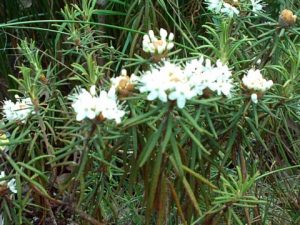 scratching and warmth of bed. Angry mood. Love for solitude. Great seriousness.
scratching and warmth of bed. Angry mood. Love for solitude. Great seriousness.
Face, Alternatively pale and red. Dry pimples like millet seed on forehead. Red nodules Boils on forehead. Skin Dry, want of natural perspiration
Natrum mur – A great homeopathy remedy for certain forms of intermittent fever, anaemia, chlorosis, many disturbances of the alimentary tract and skin. Great debility; most weakness felt in the morning in bed. Coldness.
Emaciation most notable in neck. Great liability to take cold. Dry mucous membranes. Dry eruptions, especially on margin of hairy scalp and bends of joints. Crusty eruptions in bends of limbs, margin of scalp, behind ears.
Acne in patients with oily skin. Introvert patients, thirsty, desire for salt food and aggravation by sun and heat. Thirst for large quantities of water.
Nitric acid – Anxious about his complaints, with fear of death. Sadness and despondency. Face yellow. Sunken eyes encircled by yellow. Dark yellow, almost brownish complexion.
Pimples on forehead and temples. Skin with Black pores. Bleeding eruption. Burning is very marked in most of skin complaints. Patient is very irritable has violent anger. Craving for meat and fat.
Psorinum – Homeopathic medicine for acne used when acne develops from fat, sugar, coffee, worse during menses. Acne rosacea. Greasy face. Pale, sickly look. Skin is yellow, dirty, and greasy. Roughness of knuckles.
Pimples with black points in center. Small numerous pustules, itching unhealthy. Itching, after scratching vesicles arise, when touched. Pimples are worse during menses, from fats, sugar, coffee, meat.
Pulsatilla – It is preeminently a female remedy, especially for mild, gentle, yielding disposition. Sad, crying 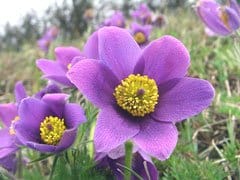 readily; weeps when talking; changeable, contradictory. The patient seeks the open air; always feels better there, even though he is chilly.
readily; weeps when talking; changeable, contradictory. The patient seeks the open air; always feels better there, even though he is chilly.
Mucous membranes are all affected. Discharges thick, bland, and yellowish-green. Often indicated after abuse of Iron tonics, and after badly-managed measles. Symptoms ever changing. Thirstless, peevish, and chilly.
Acne after taking fatty food. Acne with delayed menses. pimples aggravated at puberty and at the start of menses, in overweight girls who have delayed menses. Mild personality with low thirst.
Sulphur – Is perhaps the homeopathic remedy most often indicated in this affection, especially if chronic. Acne after abuse of cosmetics. The skin is rough and hard and the acne is associated with comedones and constipation; great aggravation from water is the characteristic leading to Sulphur in skin affections.
Face is Pale, sickly color. Heat and spotted redness of face. Black pores. Itching intensely in evening and from warmth. The acne punctata is the variety corresponding most nearly to Sulphur.
Sulphur is also useful for treatment of acne that has been suppressed with allopathic ointments.
Thuja – Homeopathic medicine for acne used when acne develops after vaccination, acne at puberty which is 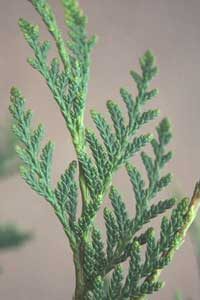 large and slow to resolve, leaves a bump after healing. Patient is often hairy and has perspiration that has strong odour and stains.
large and slow to resolve, leaves a bump after healing. Patient is often hairy and has perspiration that has strong odour and stains.
Pimples on face. Face glowing redness of whole face, with a fine network of blood vessels, as if it were marbled. oily skin. Burning heat and redness of. Flushes of heat in. Sweat on, especially on side on which he does not lie. Pimples on upper lip and chin, lips, etc.
All eruptions burn violently after cold washing. Corrosive itching. Better scratching, but then followed by burning. Painful sensitiveness of affected part. The skin symptoms better by touch. Nodular acne. Homeopathic medicine for very large cystic acne.
Cause of ACNE
The exact cause of acne is unknown, several related factors are:
- Hormonal activity supposed to be responsible, such as menstrual cycles and puberty.
- Increase in hormones called androgens (male sex hormones), which causes sebaceous glands to enlarge and make more sebum.
- Hormonal changes related to pregnancy can also cause acne.
- Another factor is heredity or genetics. Researchers believe that the tendency to develop pimples can be inherited from parents. For example, studies have shown that many school-age boys with acne have a family history of the disorder.
- Accumulation of dead skin cell.
- Bacteria in the pores, to which body becomes allergic.
- Skin irritation or scratching of any sort will active the inflammation.
- Starting or stopping birth control pills.
- Heredity (if your parents had acne, you might get it too).
- Some types of medicine.
- Greasy makeup.
Drugs: Some medications may cause or worsen pimples, such as those containing iodides, bromides, or oral or injected steroids (either the medically prescribed prednisone or the steroids bodybuilders or athletes take.) Most cases of acne, however, are not drug-related.
Pathophysiology
- Excessive secretion of oils from the sebaceous glands accompanies the plugging of the pores with naturally occurring dead skin cells (corneocytes) blocking hair follicles.
- The accumulation of these corneocytes in the duct appears to be due to a failure of the normal keratinization process in the skin which usually leads to shedding of skin cells lining the pores.
- Oil secretions are said to build up beneath the blocked pore, providing a perfect environment for the skin bacteria Propionibacterium acnes and the lipophilic (oil/lipid-loving) yeast Malassezia to multiply uncontrollably.
- Under the microscope, however there is no evidence of pooled trapped sebum. Indeed the oil perolates through the plugged duct onto the surface.
- In response to the bacterial and yeast populations, the skin inflames, producing the vision lesion.
- The face, chest, back, shoulders and upper arms are especially affected.
Types of ACNE
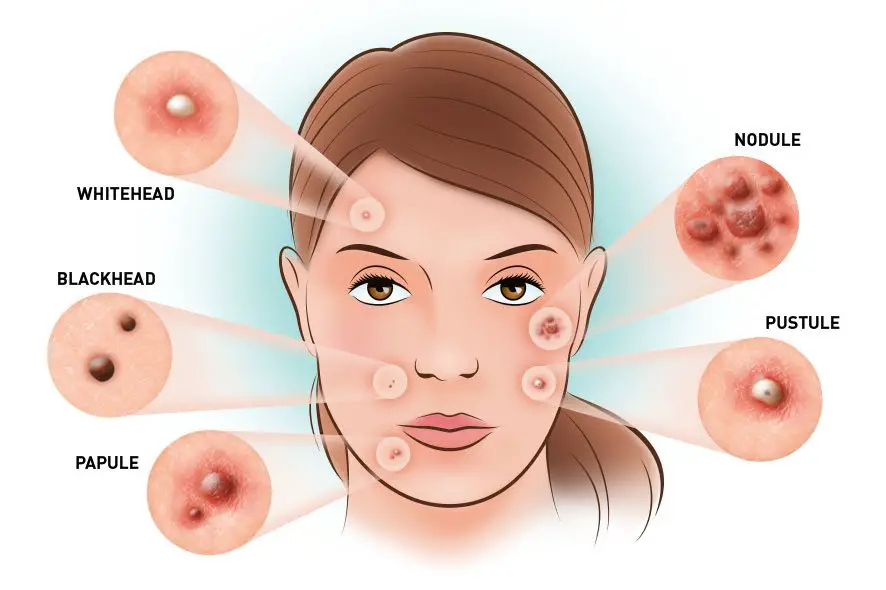
There are mainly two types of acne
- Inflammatory acne
- Non inflammatory acne
Inflammatory acne – inflammatory acne include pustule, papule, nodule and cyst.
Non inflammatory acne – include whiteheads and blackheads. The characteristic lesions of acne are the comedones which have dark horny follicular plugs. These may be open and is called “blackhead” or may be closed, which is known as “whitehead”.
Acne is a group of skin rashes with different causes named as:-
Acne vulgaris
It is most commonly experienced around puberty, typically of the face and shoulders / chest.
Acne rosacea
A red rash predominantly on the face.
Acne keloidalis nuchae (pseudofolliculitis nuchae)
A rash caused by shaving.
Acne conglobata (Hidradenitis suppurativa)
Chronic abscesses or boils of sweat gland and hair follicle; in the underarms, groin, buttocks and under the breasts in women. Homeopathic medicines like Copaiva, Artemsia vulgaris, Causticum, Argentum nitricum etc are especially useful in treatment of acne conglobata.
Acne cosmetica
It is caused by use of cosmetics.
Acne fulminans
An extreme form of acne conglobata.
Acne medicamentosa
It is caused by starting or stopping medicine.
Baby acne
A rash seen on the cheeks, chin, and forehead of infants.
Chloracne
It is caused by exposure to chlorinated hydrocarbons such as dioxins or PCBs.
###
Acne vulgaris
Acne vulgaris is an inflammatory disease of the skin, which is caused by changes in the pilosebaceous units.
It is the most common form of acne. Large number of teenagers suffers from this, during the period of puberty. In most of the cases it tends to disappear or at least decreases after one reaches early twenties. There is no fix prediction how long time it will take to disappear entirely,
Signs and Symptoms of Acne vulgaris
It typically appears on face, neck, chest, back, shoulders and the areas of skin with the largest number of functional oil glands. People with pimples frequently have a variety of lesions, some of which are shown in the diagrams below. The basic acne lesion, called the comedo, is simply an enlarged and plugged hair follicle. Acne can take the following forms;
Whiteheads: These are created when the openings of hair follicles become clogged and blocked with oil secretions and dead skin.
If the plugged follicle, or comedo, stays beneath the skin, it is called a closed comedo and produceswhite bump called a whitehead.
Blackheads: These are similar to whiteheads, but are open to the skin surface and darken.
A comedo that reaches the surface of the skin and opens up is called an open comedo or blackhead because it looks black on the skin’s surface. This black discoloration is due to changes in sebum as it is exposed to air. It is not due to dirt. Both whiteheads and blackheads may stay in the skin for a long time.
After resolution of acne lesions their may be prominent unsightly scars
Homeopathic medicines like Copaiva, Artemsia vulgaris, Causticum, Argentum nitricum, Eugenia, Carbo animalis, Ar iod, Kali brom, Tuberculinum etc are especially useful in treatment of acne vulgaris.
Acne Rosacea
Acne rosacea is a skin disorder leading to redness and pimples on the nose, forehead, cheekbones, and chin. The inflamed pimples and redness of rosacea can look a great deal like acne, but blackheads are almost never present. Fair-skinned individuals and people who flush easily seem to be more susceptible to this condition.
Rosacea becomes progressively worse in many of those affected. The real cause of rosacea is now thought to be a tendency to flush and blush in a person with sun damage. Sun damages the supporting fibers of the small blood vessels just under the surface of the skin, allowing the vessels to stretch out (become permanently dilated).
The damaged blood vessels leak fluid when flushing occurs, resulting in blotchy red areas. Swelling occurs, but is not usually so prominent to be very visible. The first sign most people see are small red pimples and pustules (pus-filled whiteheads). The redness can come and go and may be tender, inflamed and sensitive to the touch. Later, the skin tissue can swell and thicken. Eventually the redness and swelling can become permanent.
Symptoms of Acne rosacea
It may vary according to the severity of the case.
Facial flushing is the classic symptom of rosacea. Flushing is the result of increased blood flow through dilated facial blood vessels. During a flush, face can turn various shades of red depending on the amount of blood flowing through the skin.
A sufferer may experience a fire-red face during intense flushes, a mildly-red face during moderate flushes, or a barely noticeable pinkish-hue during mild flushes; it may be transient or long-standing.
Rhinophyma is a form of rosacea that is characterized by chronic redness, inflammation, and increased tissue growth of the nose.
What causes Acne Rosacea?
Acne rosacea is a disorder where the blood vessels become damaged when repeatedly dilated by stimuli.
Triggers that cause episodes of flushing and blushing.
Exposure to temperature extremes can cause the face to become flushed
Strenuous exercise,
Heat from sunlight,
Severe sunburn,
Stress,
Cold wind,
Moving to a warm or hot environment from a cold environment
Some foods and drinks that can trig the condition include alcohol, foods high in histamine and spicy food.
Certain medications
Homeopathic medicine for acne rosacea include Calcarea-silicata, Carbo animalis, Carbo veg, Cauticum, Eugenia, Lachesis, Psorinum, Sulphur, Rhus tox, Thuja, Violo-t etc.
Acne cosmetica
Persistent, low grade usually affecting the chin and cheek of a woman who uses cosmetics. People may not contribute their reactions to their reactions to their cosmetics at first, but may notice when get worsening symptoms after using certain face makeup or lip products. Certain chemicals in liquid foundation; it may cause allergic reaction.
The homeopathic remedy Bovista is most commonly indicated for treatment of acne cosmetica.
Acne Medicamentosa
Acne caused or exacerbated by several types of drugs, such as antiepileptic, halogens, and steroids. As acne is generally a disorder of the pilosebaceous units caused by hormones, the medications that trigger acne medicamentosa most frequently are hormones.
Homeopathy treatment of acne medicamentosa depends on homeopathic medicines like Kali-iod, Aurum met, Mezerum, Acid-nitricum, Pulsatilla, Sulphur etc.
Baby Acne
What causes baby acne?
Baby Acne (acne neonatorum) is a common condition that affects roughly 20 percent of newborn babies. Infants usually develop neonatal acne because of stimulation of the baby’s sebaceous glands by lingering maternal hormones after delivery.
These hormones cross the placenta into your baby and after delivery they cause the oil glands on the skin to form bumps that look like pimples. Face present with red pimples on the cheeks, forehead and chin; whiteheads may present.
Baby acne often clears up quickly [generally within 3 weeks]; in some cases, however, baby acne lingers for months or even longer. Male babies are more often affected than female babies. It is best to wash your baby’s face with warm water two or three times a day and pat it dry. Don’t use lotions, oils or other treatments. Never pinch or scrub baby acne. You may cause more irritation or an infection.
Homeopathy medicine Tuberculinum is most commonly indicated for Baby Acne.
Acne Treatment
General tips for acne
Proper hygiene should be maintained by the patients, they should clean the skin properly and patient should be advised to stop using hair oil as well as any greasy make-up on the face as it can aggravate the complaints.
Skin care to prevent acne
- Clean skin gently- Gently wash your face with a mild cleanser [according to the type of your skin], once in the morning and once in the evening, as well as after heavy exercise. It is also important to shampoo your hair regularly. If you have oily hair, you may want to wash it every day. Wash your face with plain water frequently.
- Avoid frequent handling of the skin. Avoid rubbing and touching skin lesions. Squeezing, pinching or picking blemishes can lead to the development of scars or dark blotches.
- Shave carefully- Shave gently and only when necessary to reduce the risk of nicking blemishes.
- Choose cosmetics carefully.
- Self-care measures and over-the-counter medicine have not helped after several months; Your acne is severe or getting worse; then contact your dermatologist.
- Products such as facial scrubs, astringents and masks generally aren’t recommended because they tend to irritate skin, which can aggravate acne. Excessive washing and scrubbing also can irritate skin. If you tend to develop acne around your hairline, shampoo your hair frequently.
- Try over-the-counter acne lotion to dry excess oil and promote peeling. Look for products containing benzoyl peroxide, resorcinol or salicylic acid as the active ingredient.
- Avoid irritants. You may want to avoid oily or greasy cosmetics, sunscreens, hair-styling products or acne concealers. Use products labeled “water-based” or “non-comedogenic.”
- Protect yourself from sun. For some people, the sun worsens acne.
Can homeopathy cure acne permanently?
If you are wondering if homeopathy treatment for acne works or not, then you have some good news. For most forms of acne, homeopathic remedies work, provided that the exact cause of acne and symptoms of the patient are taken into account while selecting the homeopathic remedy.
Homeopathic treatment is highly individualized and the focus is on treating the person as a whole and not just give you superficial creams and pills to suppress acne.
Some form of acne, like acne occouring at puberty, are easy to treat. Acne vulgaris and acne rosacea need more time and effort. Patients with a family history of acne also need more skill and time from a homeopathy doctor.
How much time homeopathic medicine take to work on acne?
The next question often is, how much time homeopathic medicines take to cure acne. The answer is – it varies from case to case. A recent case of acne simplex can benefit a lot within a few months. On the other hand homeopathic treatment of acne vulgaris, acne rosacea and acne scars can last for two or more years.
The above information about homeopathy treatment of acne is only for information purpose. Please consult a professional homeopath before taking any homeopathic medicine for acne.
Acne Cases Cured with Homeopathic Medicine
Hormones Made My Acne Go Into Overdrive – A Case of Folliculinum – by Helen Darroch
A Case of Little Mountain Basalt for Childhood Acne – by Sonya McLeod
Generalized Epilepsy Healed With Synthetic Prescription – by Piyu Amit Chandani
A Case of Acne Vulgaris – by Pravin Pente
Acne in a Woman of 14 – by Deanna Giles



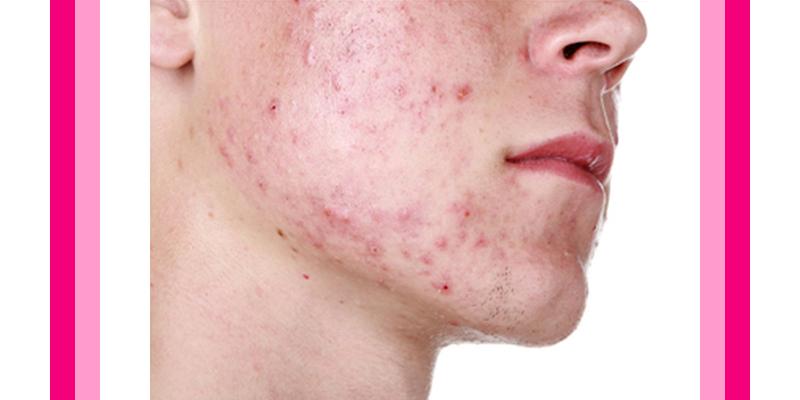

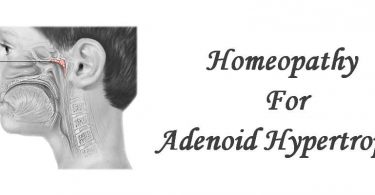
Doctor, your article on acne and pimples is really very informative and explanatory.I have tried kali brom hepar sulf belledona and calcarea sulf on young girls who come with these complains to me.
Thanks.
Asefa homoeopath.
Wow, tons of information!
Hi, can these meds (ref to Sanguarina as per my condition) be taken of the counter? I am currently taking Pimplex by SBL and it has not been very effective. My problem is acne which sometimes have white pus like formation anywhere on the face..they usually come before my menses cycle which is usually very irregular (45 to 50 days). Not to say that they only come before the cycle..they are there pretty much all the time.
There is usually just one pimple at a spot on my face…it pains and a white pus like discharge comes out second – third day..I have lot of scars from earlier acne bouts. Please help!
I have been having acne on my forehead, slightly itchy since september 2010. I thought it was because of using an oil nutritive shampoo, which was not the case. I have even changed shampoos since then, but no relief.
Please help!
excellent and very informative article. thank you.
any pimp 1st of all echenesia q and sulphur use for blood clearance.ofter all redness used baladona 200 deep under skin pimp used kali brom puss in pimp used graphites200 big pimp heaper sulph200 absus on face used single dose of silicia 1m
dry skin sulphur .
Dr misbahudin you mean for any type of acne for dry skin we can prescript SULPHUR ?
Informative artice ,THX…
If i make homeopathic handcream for each remedy that is in this article for using at the same time , do you think it will be more helpfull ? ANd also can be synergism ?
amazing article, comprehensive and informative – many thanks.
natrum sulphuricum 1 m be used for skin acnes on back and shoulder.